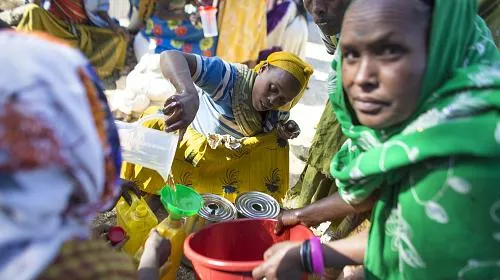Donors must close funding gap to support government efforts assisting families in need.
ADDIS ABABA (May 26, 2016) — As the effects of the El Niño drought in Ethiopia continues, the poverty-fighting organization CARE warns that of the 10.2 million people affected, an estimated 404,000[1] pregnant women and breastfeeding mothers are at particular risk of malnutrition and complications during pregnancy due to the devastating food shortages. It is expected that 27,000 women will give birth this month alone, facing the prospect of not being able to provide sufficient food and milk for their newborns.
“From our work with affected communities, we know that pregnant and breastfeeding women are at greater risk of malnutrition and they experience high levels of stress during droughts. Traditionally, women are often the last to eat in a household, and with families being forced to reduce meals to one a day, pregnant and lactating women will not get the nutrition they need,” says Esther Watts, country director for CARE in Ethiopia.
“Without proper nutrition, pregnant women will give birth to malnourished infants. Children deprived of good nutrition during the first thousand days of life often have stunted growth, poor cognitive development and low immunity to disease. It is a very vicious cycle.”
CARE workers also are observing that lactating mothers are forced to cut the frequency of breastfeeding due to their increased workload. As a result of the drought, women have to walk further to get water and many spend all day collecting firewood to sell at markets.
The drought caused by El Niño across the Horn of Africa, Southern Africa and the South Pacific has put great strain on the capacity of the global humanitarian system. In February, CARE warned that a gap in international emergency funding for the response in Ethiopia would leave communities without food within weeks. Fortunately, additional funding was secured. While a break in the food pipeline has been averted so far, the risk remains.
“We still face a massive funding gap in Ethiopia, with $702.6 million needed to support the Ethiopian government in its efforts to assist the most vulnerable people, including pregnant women and lactating mothers. We call on the international community to ensure everyone gets the assistance they need,” says Watts.
“People are already reverting to coping strategies that will have dire consequences for their futures. Girls and boys are dropping out of school to find work and help with household chores. Men are migrating to find work, while women are forced to sell off productive assets and consume seeds intended for planting to survive.”
Although much awaited rain has arrived in several areas of the country, it has actually worsened the humanitarian situation by causing floods that have claimed lives, damaged crops and delayed the delivery of emergency assistance.
CARE continues to scale up emergency assistance delivered in coordination with the government, with 675,000 people reached so far. In addition to monthly food distributions, CARE has reached 42,000 people with emergency nutritional assistance, of which 23,440 have been pregnant and lactating women. Health and nutrition education is provided to mothers and their communities, as some traditional practices and a lack of knowledge about proper feeding practices exacerbate the undernutrition stemming from reduced access to food.
Media Contacts
Nicole Harris, nharris@care.org, 404-979-9503 (office), 404-735-0871 (mobile)
About CARE
Founded in 1945 with the creation of the CARE Package®, CARE is a leading humanitarian organization fighting global poverty. CARE places special focus on working alongside poor girls and women because, equipped with the proper resources, they have the power to lift whole families and entire communities out of poverty. Last year CARE worked in 90 countries and reached more than 72 million people around the world. To learn more, visit www.care.org.
[1] 244,800 pregnant women and 159,900 mothers with babies under six months (exclusive breastfeeding) in a given month, calculated on the basis of an affected population of 10.2 million and other available statistics.

